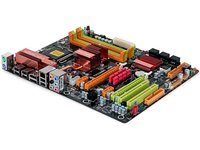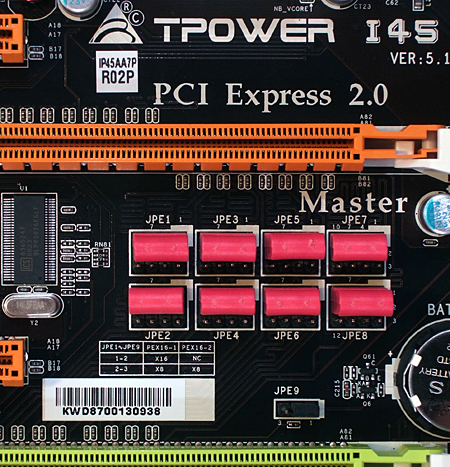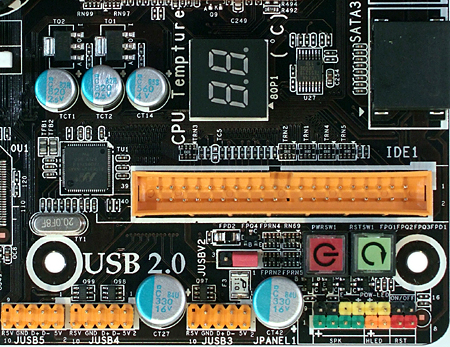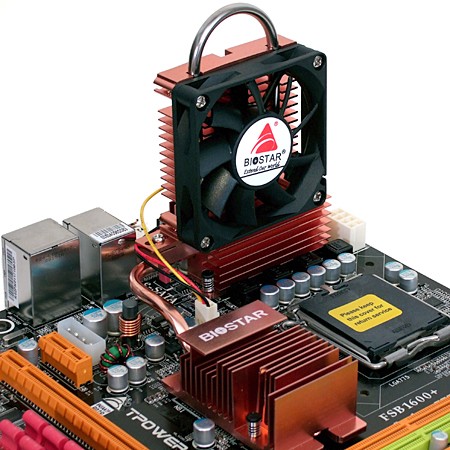11-Way P45 Motherboard Shootout
Biostar TPower i45
Surprisingly, Biostar’s second entry in today’s comparison uses a completely different circuit board, but with very few features differentiating it from the previously-described TP45 HP. Several features again put Biostar in direct competition with ASRock’s P45R2000-WiFi, but while the formerly introduced TP45 HP was $10 less expensive than the competition, the TPower i45 cost $10 more. Let’s see what buyer get from the $20 price difference between Biostar motherboards.
The TPower i45 has the eSATA ports missing from both the TP45 HP and the competing ASRock product, though the competition provides IEEE-1394 FireWire ports whereas Biostar doesn’t.


The TPower i45 starts off with a slightly larger VRM ’sink at the top and a temperature display at the bottom, with solid capacitors in all locations increasing reliability. Competitor ASRock also uses solid capacitors, but lacks the temperature display and VRM sink.
Our concerns about the SATA ports of Biostar’s TP45 HP have been fully addressed in its TPower i45, as two graphics cards of any size can now be used. Unfortunately the fix was made by pointing all the ports forward, which will prevent the TPower i45’s use in cases that have a drive cage next to the motherboard’s front edge. And though the Ultra ATA connector will be blocked by any oversized card in the lower x16 slot, crafty builders will find that the cable can be run underneath the card so long as they install it before the card.
The inconvenience of eight jumper packs still falls behind the competitor’s less-inconvenient paddle card design, but offers the opportunity for experimenters to play with various transfer modes to the lower slot. The maximum number of PCI Express 2.0 pathways available to the lower slot is eight, which are taken away from the upper slot due to P45 Express chipset limitations.
Three slots of space separate top and bottom graphics cards for optimal cooling, and the space immediately below the primary PCI-Express x16 graphics slot is left empty since the location is not useful anyway.
Ultra ATA, floppy, and Front Panel Audio connections are all located in the worst possible locations for cable installation. Although most modern system won’t use the Ultra ATA or Floppy connector, the front panel audio header, found in the bottom rear corner, is unreachable in many case designs. Most other companies do this, but that fact is of little consolation to builders.
Get Tom's Hardware's best news and in-depth reviews, straight to your inbox.
Power and Reset buttons are conveniently located for bench-top testing, and below these are three USB 2.0 headers which support up to six front panel ports or bay devices.
An accessory chipset cooler included in the TPower i45 installation kit draws heat away from the P45 Express northbridge through an interlinking heat pipe.
Current page: Biostar TPower i45
Prev Page TP45 HP Software And Accessories Next Page TPower i45 Onboard Devices-
nickchalk Where are the lower price P45 M/B ?Reply
Asus P5Q pro is out for €110 and P5Q deluxe for €165 the price difference is about 70$ in Greece. -
Proximon I suppose I can get some good from having read this. Did you get paid by the word? Maybe next time you could just put together a complete features chart so that we can have some convenient comparison? You know, so someone could go to a chart and see at a glance which boards had eSATA or firewire, or 8 USB.Reply
-
JPForums I'd rather have the overabundance of information than a lack of information. Presentation could use a little refining (I.E. comparison charts and the likes), but having the relevant information available at least is a good thing.Reply -
the introduction and specifics are nice, the comparision isn't. so, why don't you test with an 8500 or qx9650? 6850 are outdated... and a mobo handling a c2d doesn't mean it can handle a quad too, see P5K for example (it stinks when it comes to a q6600).Reply
-
Crashman procithe introduction and specifics are nice, the comparision isn't. so, why don't you test with an 8500 or qx9650? 6850 are outdated... and a mobo handling a c2d doesn't mean it can handle a quad too, see P5K for example (it stinks when it comes to a q6600).Reply
Tom's Hardware wants the performance of current articles to reflect that of recent articles, so a "standard test platform" was chosen a while ago. It will get updated, but probably not before the new socket becomes widely available. -
zenmaster I would have liked to see something such as a P35 and an X48 as controls to help analyze the P45 Performance.Reply
In otherwords, What is the P45 Gaining me over the older P35.
What would I gain by going to the X48. (Or Lose) -
Crashman zenmasterI would have liked to see something such as a P35 and an X48 as controls to help analyze the P45 Performance.In otherwords, What is the P45 Gaining me over the older P35.What would I gain by going to the X48. (Or Lose)http://www.tomshardware.com/reviews/intel-p45-chipset,1961.htmlReply -
johnbilicki The first 17 pages were filled with nothing but junk from ASUS. Do us a favor: don't even bother featuring or *MENTIONING* anything for any reason from a company that refuses to RMA 200-400 dollar brand new motherboards with anything other then used and usually broken junk. It destroyed my enthusiasm for the article.Reply -
dobby nickchalkWhere are the lower price P45 M/B ?Asus P5Q pro is out for €110 and P5Q deluxe for €165 the price difference is about 70$ in Greece.Reply
the p5q PRo is a p43 board, i should know i have one



